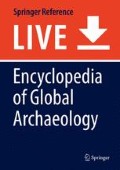References
Allen, M.J., and J. Gardiner. 2009. If you go down to the woods today; a re-evaluation of the chalkland postglacial woodland; implications for prehistoric communities. In Land and people; papers in memory of John G. Evans, Prehistoric Society research paper 2, ed. M.J. Allen, N. Sharples, and T.P. O’Connor, 49–66. Oxford: Oxbow.
Buckman, J. 1864–1866. Notes on the flora of Silbury Hill. Wiltshire Archaeological and Natural History Magazine 9: 159–162.
Campbell, G. 2014. Silbury Hill: Understanding the environment. In Silbury Hill. The largest prehistoric mound in Europe, ed. J. Leary, D. Field, and G. Campbell. Swindon: English Heritage.
Canti, M.G. 2003. Earthworm activity and archaeological stratigraphy: A review of products and processes. Journal of Archaeological Science 30: 135–148.
Canti, M.G., G. Campbell, D. Robinson, and M. Robinson. 2004. Site formation, preservation and remedial measures at Silbury Hill, (Report 61/2004). Portsmouth: English Heritage/Centre for Archaeology.
Canti, M., M. Collinson, G. Campbell, A. Brain, R. Smith, M. Lillie, and I. Douterelo-Soler. Understanding preservation and formation processes. In Silbury Hill. The largest prehistoric mound in Europe, ed. J. Leary, D. Field, and G. Campbell. Swindon: English Heritage.
Collinson, M.E., A. Brain, and G. Campbell. 2011. Green plant material recovered from the early phases of Silbury Hill (2007/08 excavations): An explanation for the unusual preservation? Research department reports 61/2011. Swindon: English Heritage.
Evans, J.G. 1972. Land snails in archaeology. London: Seminar Press.
Field, D., and J. Leary. 2014. Preparations: The setting, previous research, recent research and surveys. In Silbury Hill. The largest prehistoric mound in Europe, ed. J. Leary, D. Field, and G. Campbell. Swindon: English Heritage.
Hall, A. 2003. Recognition and characterisation of turves in archaeological occupation deposits by means of macrofossil plant remains, Centre for Archaeology Report 16/2003. Portsmouth: English Heritage.
Hall, A., and G. Campbell. 2014. Mosses. In Silbury Hill. The largest prehistoric mound in Europe, ed. J. Leary, D. Field, and G. Campbell. Swindon: English Heritage.
Karg, S. 2008. Direct evidence of heathland management in the early Bronze Age (14th century B.C.) from the grave-mound Skelhøj in western Demark. Vegetation History and Archaeobotany 17: 41–49.
Leary, J. 2014. The evolution of a Neolithic mound: The prehistoric sequence. In Silbury Hill. The largest prehistoric mound in Europe, ed. J. Leary, D. Field, and G. Campbell. Swindon: English Heritage.
Leary, J., and D. Field. 2010. The story of Silbury Hill. Swindon: English Heritage.
Leary, J., and D. Field. 2014. Ways of understanding prehistoric Silbury Hill. In Silbury Hill. The largest prehistoric mound in Europe, ed. J. Leary, D. Field, and G. Campbell. Swindon: English Heritage.
Leary, J., D. Field, and G. Campbell, eds. 2014. Silbury Hill. The largest prehistoric mound in Europe. Swindon: English Heritage.
Marshall, P.D., A. Bayliss, J. Leary, G. Campbell, F. Worley, C. Bronk Ramsey, and G. Cook. 2014. The Silbury chronology. In Silbury Hill. The largest prehistoric mound in Europe, ed. J. Leary, D. Field, and G. Campbell. Swindon: English Heritage.
Merewether, J. 1851. Diary of a dean: Being an account of the examination of Silbury Hill and of various barrows and other earthworks on the downs of north Wilts, opened and investigated in the months of July and August 1849. London: George Bell.
Robinson, M. 1997. The insects from Silbury Hill. In Sacred mound, holy rings. Silbury Hill and the West Kennet palisade enclosures: A later Neolithic complex in North Wiltshire, Oxbow book monograph 74, ed. A. Whittle, 36–47. Oxford: Oxbow.
Whittle, A. 1997. Sacred mound, holy rings. Silbury Hill and the West Kennet palisade enclosures: A later Neolithic complex in North Wiltshire, Oxbow book monograph 74. Oxford: Oxbow.
Williams, D. 1976. A Neolithic moss flora from Silbury Hill, Wiltshire. Journal of Archaeological Science 3: 267–270.
Worley, F. 2014. The antler. In Silbury Hill. The largest prehistoric mound in Europe, ed. J. Leary, D. Field, and G. Campbell. Swindon: English Heritage.
Author information
Authors and Affiliations
Corresponding author
Section Editor information
Rights and permissions
Copyright information
© 2018 Springer International Publishing AG, part of Springer Nature
About this entry
Cite this entry
Campbell, G., Canti, M. (2018). Silbury Hill: Environmental Archaeology. In: Encyclopedia of Global Archaeology. Springer, Cham. https://doi.org/10.1007/978-3-319-51726-1_864-2
Download citation
DOI: https://doi.org/10.1007/978-3-319-51726-1_864-2
Received:
Accepted:
Published:
Publisher Name: Springer, Cham
Print ISBN: 978-3-319-51726-1
Online ISBN: 978-3-319-51726-1
eBook Packages: Springer Reference HistoryReference Module Humanities and Social SciencesReference Module Humanities

